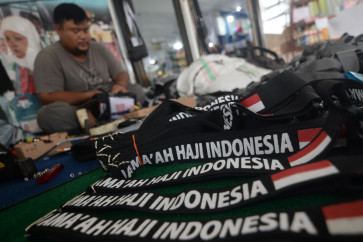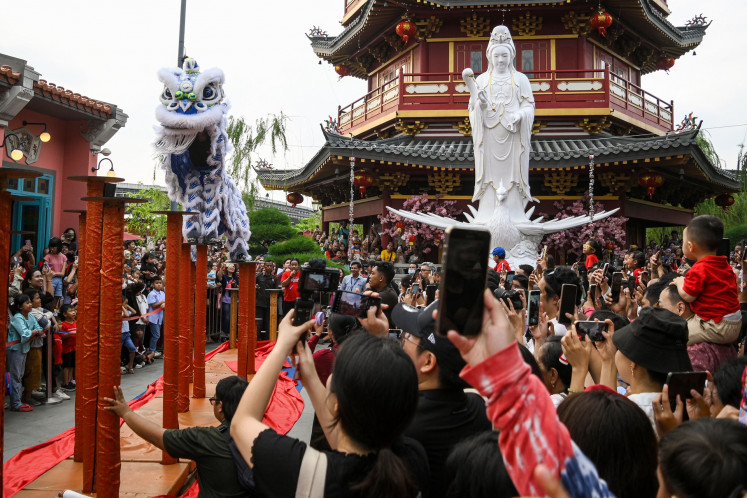Let's discuss water scarcity
The Chinese government has made a huge effort to improve air quality and beautify Beijing for the Olympics that open on Friday (8 August)
Change text size
Gift Premium Articles
to Anyone

The Chinese government has made a huge effort to improve air quality and beautify Beijing for the Olympics that open on Friday (8 August). But it cannot apply a short-term 'fix' to another problem that visitors to the Games will not see - the steady depletion of underground water supplies in northern China, where the capital is located.
A study published in June by Probe International, a Canadian environmental research group, found that over two-thirds of Beijing's water is being pumped from beneath the ground to compensate for dwindling surface water from reservoirs and rivers that once supplied the city.
It warned that the underground saturation level, known as the water table, is dropping because water is being pumped out faster than it can be replenished, and that plans for long distance water diversion will aggravate the impending crisis unless water is used much more efficiently.
Two years ago, the Bureau of Hydrology and Water Resources in Hebei Province, a major source of water for both Beijing and Tianjing, issued a similarly stark warning. It said that only severe over-exploitation of underground water was making up for the shortfall between water from rain and rivers, and rapidly rising demand from urban residents, industries and agriculture.
Although the Olympics have swung the focus of international attention to China's many achievements and problems, water shortage is not just a local issue affecting Beijing and surrounding areas.
Tushaar Shah is an Indian hydrologist with the International Water Management Institute, part of a worldwide network of farm research centres funded by the World Bank. He estimates that India, China and Pakistan together pump approximately 400 cubic kilometres of water out of the ground each year, about twice as much as is recharged by rain. These three countries, with a combined population of nearly 2.6 billion, account for more than half the world's use of underground water for agriculture.
However, they are not alone. The drilling of millions of deep wells and the extensive use of farm pumps to bring the water to the surface in the past fifteen years in many parts of Asia, including Indonesia, Vietnam, Bangladesh and Sri Lanka have helped raise food production - but at a long-term cost of diminished underground water supplies that are emergency stores for the future.
Excessive pumping of water from beneath greater Jakarta is causing parts of the city to sink and allowing salt water from the nearby sea to filter in, contaminating a valuable reservoir of fresh water. Similar over-exploitation of aquifers has taken place in the Middle East, South America, the United States and Australia.
Until a couple of years ago, the world was growing twice as much food as it did a generation earlier. However it was using three times as much water to grow this food. Two-thirds of all the water irrigates crops. For example, it takes about 1,000 litres of water to grow one kilogram of wheat and between 2,000 and 5,000 litres of water to produce a kilo of rice.
By some calculations, as much as 10 per cent of the world's food is being grown using underground water that is not being replaced by rain. As global warming intensifies, the implications for water security and food production are alarming. China is the world's biggest grain producer, and over half its wheat and a third of its corn are grown on the northern plain. However, the water table under the plain is falling fast.
Over-pumping has largely depleted shallow aquifers, prompting well drillers to tap deep acquifers which scientists say are so far below the surface that they are not replenished by rainwater seepage. Several years ago, the Geological Environmental Monitoring Unit in
Beijing reported that under Hebei province, in the heart of the northern plain, the average level of deep acquifers was dropping by nearly 3 metres a year. As farmers in this semi-arid region are unable to continue drawing water from underground to irrigate their crops, production will decline. Officials have said water shortages will soon make China dependent on grain imports. The World Bank has warned that China faces "catastrophic consequences for future generations" unless water use and supply are brought back into balance.
In India, the situation is worse because farming is even more critical to human survival and economic growth than in China. Nearly 70 percent of India's population relies on agriculture, which accounts for about a quarter of GDP. Underground water, which now supplies 80 per cent of farm water, has become vital for sustaining crops.
Yet, as the water table in many parts of India falls, water shortages will become more widespread and the cost of pumping the remaining undergroun water to the surface will rise. In a country where poverty is extensive, one-third of the land is semi-arid and rainfall is seasonal and erratic, this will make it difficult for many farmers to grow enough food unless they find ways of conserving rainwater and using it sparingly.
The writer, a former Asia editor of the International Herald Tribune, is an energy and security specialist at the Institute of South East Asian Studies in Singapore.









